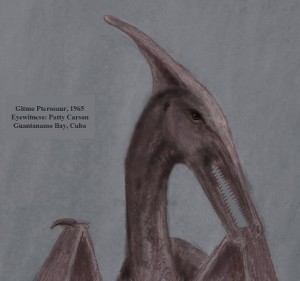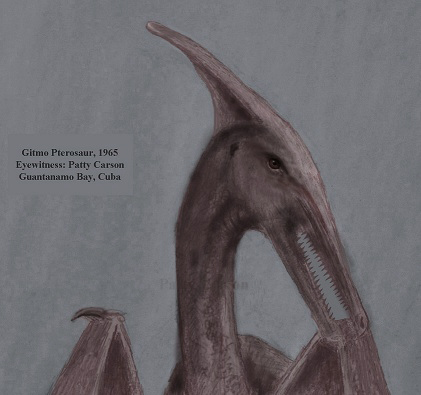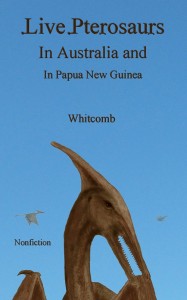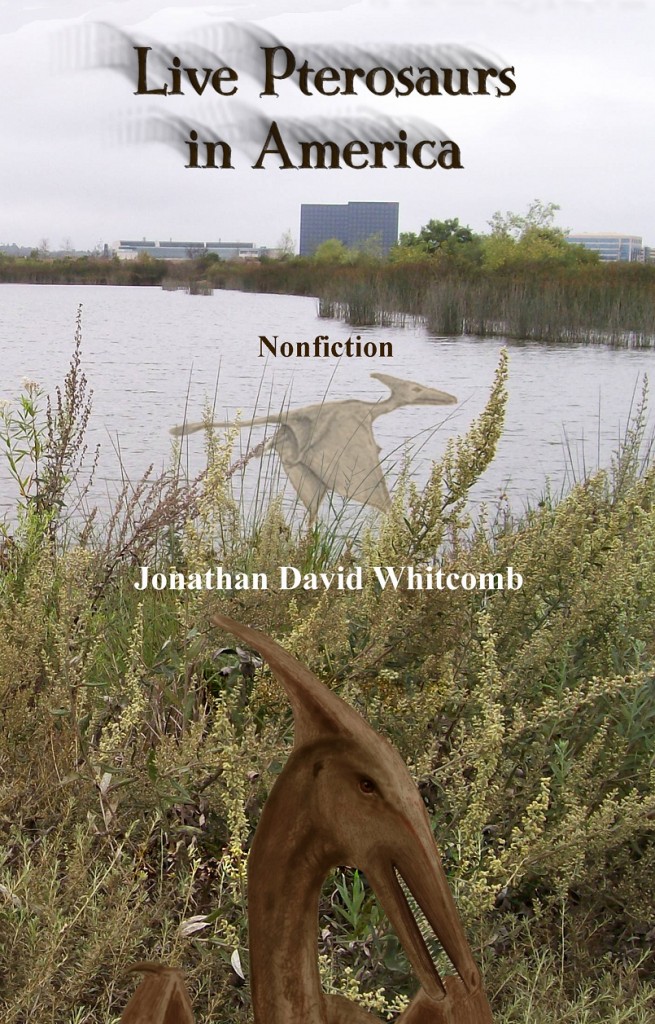By Jonathan Whitcomb, author of nonfiction cryptozoology books
I recently came across a series of comments in the cryptozoology section of Reddit. Here’s part of what one skeptic said about eyewitness reports from North Carolina:
“nonsensical ‘head-crest and long tail with a diamond fin’ description”
It is a strange description, to be sure, that combination of a head crest and a Rhamphorhynchoid-like tail that has a structure at tail-end. It appears almost as strange as a description of a platypus, to someone who knows about mammals and ducks but who has been ignorant of that strange animal that now lives in Australia.
I suggest the countless sightings of ropens around the world—that demonstrates that this animal now lives worldwide. The critic who threw up that comment on Reddit was surely ignorant of just how many persons have reported a living ropen. And eyewitnesses live in many countries of the world, not just in North Carolina.

Eskin Kuhn, a U.S. Marine at Guantanamo Bay, Cuba, in 1971, is a talented artist. He witnessed two “pterodactyls” flying at “close range” and not high above the ground. He concentrated on their appearance so that he could sketch out details later. He drew the above sketch within minutes of his sighting, which encounter was on a clear day.
Notice the combination of a long tail with a tail-end structure and that horn-like head crest. Mr. Kuhn had no idea that during World War II, in the Pacific, an American soldier had a close encounter with a “huge” flying creature that brought to mind the word “pterodactyl.” That one also had a long tail (“at least ten or fifteen feet” in length) and a horn-like head crest.
Sightings in New Guinea, decades ago
The late World War II veteran Duane Hodgkinson freely described the long-tailed flying creature he and his army buddy observed in a jungle clearing west of Finschhafen, New Guinea, in 1944. He did not focus, at the time, on the end of the tail of the “pterodactyl,” for he was concentrating much more on the head. He made it clear, however, that the long tail was separate from the legs, for he clearly saw the legs when the creature was running to get up off the ground while it was taking off.
But Hodgkinson saw the head crest and approved the sketch that was made according to his guidance. Brian Hennessy also saw a large flying creature with a long tail, and that was on Bougainville Island, New Guinea, in 1971, the same year as the sighting by Eskin Kuhn, on the other side of the world.
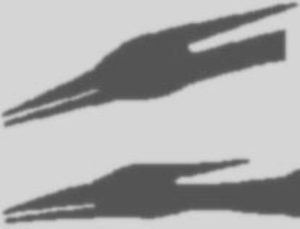
Ropen-pterosaur: 1971 (top) and 1944 (bottom)
Notice the similarities in the two sketches above. The top head-sketch was chosen by Brian Hennessy; the bottom, by Duane Hodgkinson. Although the sightings were in different decades, the proximity (eastern mainland of New Guinea and Bougainville Island) and the similarities in the choices made by those two men—those point to the large flying creatures being either the same species or a closely related species.
More on a Head Crest and a Rhamphorhynchoid Tail
So we have two Western eyewitnesses of apparent ropens in New Guinea and one American soldier in Cuba, with sketches corresponding to those three sightings. We actually have more than that: Take the report by the American Patty Carson. She saw a flying “dinosaur” at Guantanamo Bay but several years before the sighting by Eskin Kuhn.
Sketch by the eyewitness Patty Carson
This eyewitness drew her sketch long after the sighting she had in Cuba, but she has something in common with Mr. Kuhn, aside from encountering a ropen: She is a talented artist who can draw realistically from memory. Notice the horn-like head crest on the above sketch.
You may respond with something like this: Carson’s sketch does not have any long tail. Yes, that is true. But she remembers seeing a long tail on that “dinosaur” and she remembers the flange that she saw on the end of that tail.
The combination of a head crest and a long Rhamphorhynchoid tail, with a “diamond” or “spade” or “triangle” at tail end—that may be relatively rare in a pterosaur fossil, but it’s common in sighting reports of modern ropens. Despite remarks from critics, this is a real animal and described in similar ways, if not in the exact same words, by eyewitnesses in different areas of the planet and from different human cultures.
###
.
Encounters with strange flying creatures
.
Another Living Pterosaur in North Carolina
It was so big I could easily make out the features. . . . I estimate wingspan was like 10 to 15 feet.
.
The reports of living pterosaurs are not birds
I know of three cases in which a person has seen a frigatebird, or a photo or video of that kind of oceanic bird, and thought it was a living pterosaur (or at least he put forward the idea that it was a non-extinct pterosaur). Take that in context: Over the past thirteen years, I’ve looked at hundreds of eyewitness sighting reports of possible living pterosaurs.
.
Ropen — a Myth or a Living Reality?
Why do critics of these investigations proclaim so ardently the religious beliefs of cryptozoologists who interview eyewitnesses of apparent pterosaurs?
.
The pterosaur suborder of Rhamphorhynchoidea, those long-tailed featherless flying creatures—they’re also called basal pterosaurs. For generations, many scientists have assumed that they became extinct, at least for most of their species, before the last of the Pterodactyloid pterosaurs dominated the skies, many millions of years ago. At least that has been the assumption.
.



